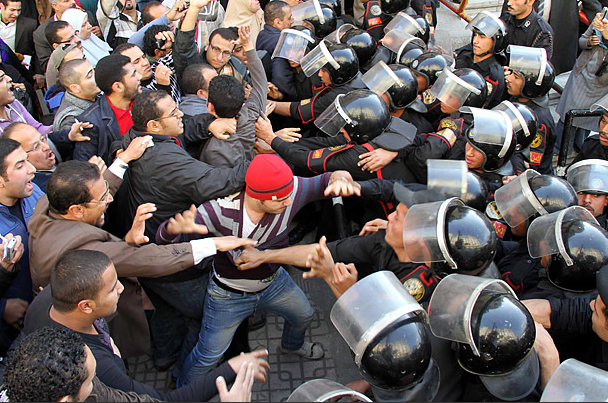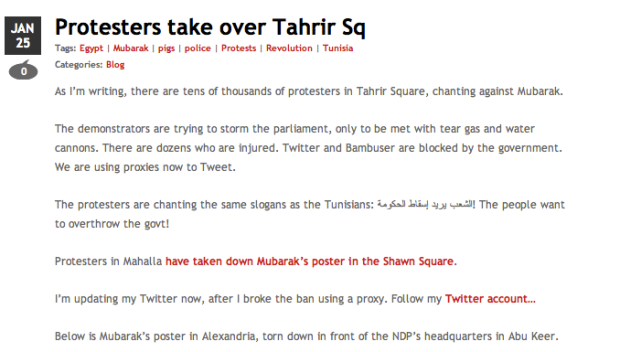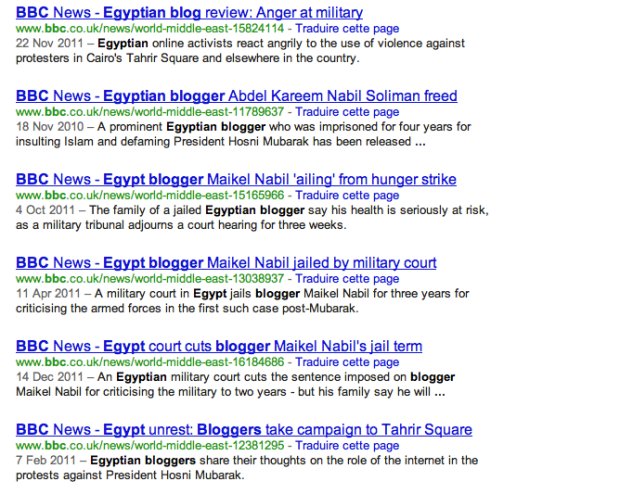Posts Tagged Egyptian uprising
How citizen journalism landscaped the Egyptian Uprising
Posted by sarabandelier in Uncategorized on November 25, 2012
Ever heard of Wael Ghonim, Ramy Raoof, Alaa Abdel Fattah, Manal Hassan, Mahmoud Salem or Hossam El-Hamalawy? Those are just a few names amongst many bloggers, cyberactivists and citizen journalists who shaped the Egyptian Revolution and traditional media landscape. The world made them famous during and after the 18 days of the Egyptian Uprising. This article will give you a glimpse at the role these citizen journalists played during the Revolution, but also in Egypt in general. Sara Bandelier
If you want to free a society just give them Internet access – Wael Ghonim
Since the 1950s, Egypt’s state media has been owned and controlled by those who govern. From Nasser to Mubarak, national media had only covered stories they were told to cover and showed a unique perspective promoting the presidential regime. Traditional media then meant propaganda.
The Internet wasn’t slow in sweeping the dusty media landscape in Egypt. On the contrary, Egyptian citizen journalists were training and learning from those new technological tools long before the 2011 Revolution.
The Kefaya movement in 2004, the April 6th movement in 2008 and the October 9th Maspero protest in 2011 shaped the way Egyptian citizen journalism would have an impact on a national and international scene. From learning how to use ghost servers to street reporting, Egyptian activists were ready to attract the attention of millions of people and challenge the regime.
It’s the new media, the people’s media, that exposes the truth – Hany Shukrallah, editor of Ahram Online
The Egyptian cyberactivists and citizen journalists took upon themselves to show the world the true face of Egypt’s political and military regime. A face that violently silences the voices of those who seek change, who question Egypt’s regime and who fight for their rights (see We are all Khaled Said Facebook page).
Facebook gave them the possibility to organize street protests and connect people with similar opinions, Youtube promoted video footage filmed by citizen journalists. These videos were then relayed by traditional medias. Twitter helped coordinate protests and reach international media by recording the activities and events during the uprising.
There is a burgeoning movement for press freedom in Egypt – Sharif Abdel Kouddous
On the one hand, there was controlled state-media. On the other, the openness of Internet. With those two components, citizen journalism could only play a big role in such a Revolution. Not only for nagging the authority, attracting the attention of international media, or Egyptians. Citizen journalism had a role to play given the challenges professional journalists had to face when trying to do their work.
You might ask yourselves, as I did, how can a citizen journalist outrun a professional journalist?
You’re in an angry street filled with protestors who do not have a very good opinion of traditional media. A square where the police and military are watching all of your moves and ready to attack you. You are there, with your camera, a microphone and all those other little things journalists need, trying to interview people and film the event… not very discreet!
Laurent Burkhalter, a Swiss TV journalist, recounts how a mob turned against his camera man and himself in the Choubra district of Cairo, one week after the demonstrations had started. ” For many days, the state TV had been saying that foreign journalists were in fact Israeli spies in disguise and agitators. The crowd accused us of being precisely that and despite our attempt to reason with them, they attacked my camera man, injuring him and breaking his camera.”
What could professional journalists do then? Well, there weren’t a lot of options left. Either acting as Al Jazeera did when the police shut down their offices: abandon their cameras and blend in the mass. Or, film from an apartment building.
What would you rather want to see when seeking for news about the uprising? Footage and pictures of citizen journalists who are in the crowd or footages taken by professional journalists who need to stay locked up in an apartment? The answer was clear for some professional journalists who increasingly relied on amateur materiel.
“Many foreign journalists were attacked, but taking risks is part of their job. The people who really risked their lives were the citizens who demonstrated while filming, or not, against their regime”, says Laurent Burkhalter.
As Hossam El-Hamalawy said “[egyptian] newspaper journalists would cite bloggers who posted the videos, thus absolving themselves of direct responsibility for the story. Alternative media is used by the traditional media so the news can reach tens of millions of people in this way”.
Seeing the importance of citizen journalism, activists came together to build up citizen media collectives that would teach people how to use their phones to record and photograph the uprising. Mosireen and Rassd News Network (RNN) are the two major citizen journalism collectives. They collected the videos and pictures, fact-checked and formatted them before publishing them online.
For you to judge the effectiveness of such a work, below is footage edited by two members of the Mosireen collective: Cressida Trew and Aida El Kashef.
“[…] the Mosireen activists staged a series of public screenings of video that challenged official accounts of clashes, like the claim that the security forces only used force against “thugs”, not peaceful protesters“. More than showing the truth, the citizen journalism collectives aimed to pave the way for the state egyptian media to follow.
However, I wondered how could one know whom to trust or not? Indeed, the risk of manipulation is great. “In conflict, the first casualty is always truth. Both sides try to gain the upper hand through false information, both offline and online. For example, there were constant rumors in Cairo that Mubarak had left the country during the Revolution, before it was over”, says Laurent Burkhalter.
Journalists moved cautiously in such a rumor prone environment. One day, according to Laurent Burkhalter, “the foreign press in the hotel lobby was talking about a massive shipment of live ammunition that supposedly had just arrived in town, and that the army was going to use it on the demonstrators. So we just did our job, talking to as many different people as possible, cross referencing every assertion”.
The beauty of online information is that it is immediately cross checkable. The mass of bloggers coinciding with the same version of events gave a clear, credible narrative of the revolution.
When us bloggers began to post videos, that gave courage to traditional journalists to cover the story as well – Hossam El-Hamalawy
In just a few words, Hossam El-Hamalawy shows us how citizen journalism didn’t just cover the Egyptian uprising. Neither did it only aim to show the truth. Citizen journalism proved that freedom of press and expression was possible, thanks to the Internet.
Even when the government shut down access to social media, nothing stopped the Egyptians. As Wael Ghonim said on the Travis Smiley Show, “it made us think we are stronger. Many Egyptians also moved down in the streets on January 28th because the internet was closed”. Citizen journalists, bloggers and cyberactivists drew so much attention that the world was at their feet. It needed the information and had to support the movement. Unprecedented help came to the Egyptians to get them Internet and mobile access.
Internet gave the feeling that others cared about what is happening – David Keyes
That is a quote I could not agree with more. This feeling gave the Egyptians the courage they needed to be active online, and therefore attract dozens of thousands of people who would then have the courage to brave the Egyptian government offline.
Combining the online and offline activism is what led them to win their battle. Citizen journalism gave them the possibility to open our – everyone’s – eyes, to see the truth, to understand the battle and to grasp the importance of freedom of press and speech. The active role of citizen journalism during the Egyptian Uprising showed national media that their role wasn’t propaganda but saying the truth!
Wael Ghonim explaining the 2.0 Egyptian Revolution at the TED conference.
The amount of videos, interviews, posts and news relayed by international media proves the major role citizen journalists played during the Egyptian Revolution. Not a single media hasn’t mentioned the faces of those cyberactivists: BBC, Washington Post, Al Jazeera, New York Times, The Guardian, Radio Télévision Suisse, you name it, have all fed on their stories and posts.
I am convinced citizen journalism had its role to play during the Egyptian Uprising, and still has a lot to do today to continue its goal in shaping a new landscape for traditional egyptian media.
Tell me, what kind of role do you think citizen journalism played during the Egyptian Uprising? And, how do you think the Egyptian Revolution would have turned out without citizen journalism?
To conclude, here’s a video that has been widely spread on Youtube, Facebook and on News channels.





